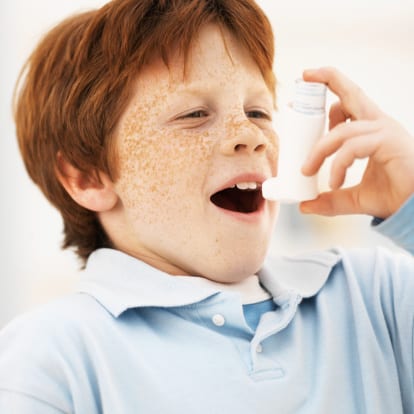Your daughter loves soccer, but lately, she has to rest on the bench twenty minutes into every game. After he finishes a swimming race, your son sits at the edge of the pool for several terrifying minutes, wheezing and coughing.
If these scenarios sound familiar, your child might have exercise-induced asthma, or EIA. As the name implies, EIA is a type of asthma triggered mostly by aerobic exercise. If you’re worried that your child has EIA, it’s best to talk to your doctor, who can work with you and your child to manage the condition.
Faster Breathing, Colder Air
We breathe differently when we exercise than when we’re at rest: our breaths are faster and shallower, and we’re more likely to breathe through our mouths. The difference is more pronounced in children than in adults, which is why kids often suffer from EIA and then seem to grow out of it. Quick, shallow breathing brings cold, dry air into the lungs. The airways in our lungs get narrower when we breathe cold air, which reduces lung capacity, making it harder to breathe. The medical term for narrow airways is “bronchoconstriction,” so many doctors refer to sports-induced asthma as Exercise-Induced Bronchoconstriction. When a person’s airways constrict so much during exercise that they can no longer get enough oxygen, they develop asthma symptoms.
Signs of an Asthma Attack
Exercise-induced asthma isn’t just feeling exhausted or winded. The most obvious and common symptom is wheezing and coughing during or after vigorous, aerobic exercise. Asthma patients have wheezing or coughing fits that are hard to stop, and they feel like they can’t catch their breath. Sometimes, a coughing fit doesn’t happen right away: many asthma sufferers begin coughing or wheezing when they come indoors after exercise, triggered by the change in temperature around them. Many people with asthma also feel pain and tightness in their chests, sometimes as a warning that an attack is on its way, and sometimes as a result of prolonged coughing and wheezing. Difficulty breathing can lead to fatigue and disorientation, so decreased stamina is a warning sign, too. If your child suddenly can’t run for more than a few minutes without feeling tired and short of breath, he might have asthma.
Tests and Treatment
Doctors have several ways of testing whether a child is struggling with asthma. Many other conditions – some of them serious – can cause shortness of breath, so your doctor will want to make sure that asthma is the real problem. In most cases, the doctor will give your child a baseline test, to see if she breathes well when she is resting. The initial test will probably be a spirometry test, in which a machine measures how much air your child can inhale and exhale. After the baseline, the doctor will ask your child to run on a treadmill, run outside, or play the sport that triggers the asthma symptoms. After this exercise, the doctor will give your child another breathing test to see if there is a difference from the baseline.
Most doctors treat asthma with a combination of medication and management. Your doctor might prescribe a drug like albuterol that your child can inhale before he exercises to widen his airways. The doctor will talk to your child about avoiding triggers like cold weather and about techniques to slow down her breathing. No matter what, your doctor will encourage your child to keep exercising. Asthma shouldn’t keep your child from playing the sports he enjoys: many athletes have overcome the condition to win Olympic medals!





